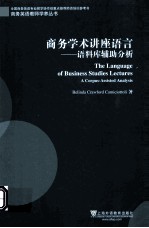图书介绍
商务学术讲座语言 语料库辅助分析 英文版PDF|Epub|txt|kindle电子书版本网盘下载

- 卡密乔托里(BelindaCrawfordCamiciottoli)著 著
- 出版社: 上海:上海外语教育出版社
- ISBN:9787544637633
- 出版时间:2014
- 标注页数:236页
- 文件大小:43MB
- 文件页数:265页
- 主题词:商务-英语-语言学-研究
PDF下载
下载说明
商务学术讲座语言 语料库辅助分析 英文版PDF格式电子书版下载
下载的文件为RAR压缩包。需要使用解压软件进行解压得到PDF格式图书。建议使用BT下载工具Free Download Manager进行下载,简称FDM(免费,没有广告,支持多平台)。本站资源全部打包为BT种子。所以需要使用专业的BT下载软件进行下载。如BitComet qBittorrent uTorrent等BT下载工具。迅雷目前由于本站不是热门资源。不推荐使用!后期资源热门了。安装了迅雷也可以迅雷进行下载!
(文件页数 要大于 标注页数,上中下等多册电子书除外)
注意:本站所有压缩包均有解压码: 点击下载压缩包解压工具
图书目录
CHAPTER 1 Introduction1
1.1 Rationale for the study1
1.2 The university lecture:pros and cons2
1.3 Aims of the study4
1.4 Target readership6
1.5 Overview of the book6
CHAPTER 2 Background to the study:The merger of discourses9
2.1 Introduction9
2.2 Spoken discourse9
2.2.1 The linguistic/discursive approach10
2.2.2 The interactional approach13
2.3 Academic discourse15
2.4 Disciplinary discourse:the field of economics21
2.5 Professional discourse:the world of business25
2.6 A conceptual framework for analyzing business studies lectures28
CHAPTER 3 The business studies lecture corpus:Design,collection and analysis31
3.1 Introduction31
3.2 Corpus design31
3.3 Collecting the data34
3.4 Transcribing the data36
3.5 Methodology:an integrated approach39
3.5.1 Quantitative and qualitative analysis39
3.5.2 Comparative analysis41
3.5.3 Behavioural observation42
3.5.4 Participant feedback43
CHAPTER 4 Speaking to the audience45
4.1 Introduction45
4.2 Speech rate46
4.3 Lecture style49
4.3.1 Discourse dysfluencies52
4.3.2 Reduced forms54
4.4 Lexical informality57
4.4.1 Vagueness58
4.4.2 Idioms62
4.5 Syntactic informality65
4.5.1 Ellipsis66
4.5.2 Non-restrictive which-clauses68
4.6 Lexical density73
4.7 Summary of findings76
CHAPTER 5 Interacting with the learners79
5.1 Introduction79
5.2 Discourse structuring79
5.2.1 Lecture macrostructure80
5.2.2 Macromarkers84
5.2.3 Micromarkers89
5.3 Evaluation94
5.3.1 Relevance markers96
5.3.2 Afiect markers100
5.4 Lecturer-audience interaction104
5.4.1 Questions105
5.4.2 Comprehension checks108
5.4.3 Dialogic episodes109
5.5 Audience responsiveness and feedback113
5.6 Summary of findings115
CHAPTER 6 Teaching the discipline and the profession119
6.1 Introduction119
6.2 Disciplinary/professional orientations:a descriptive profile120
6.3 Real vs.hypothetical worlds122
6.4 Argumentation125
6.5 Specialized lexis127
6.5.1 Global analysis128
6.5.2 Keyword analysis131
6.5.3 Connections to Business English135
6.5.4 Compounds and buzzwords138
6.6 Metaphors142
6.6.1 Global analysis144
6.6.2 Comparative analysis147
6.7 Summary of findings148
CHAPTER 7 Beyond speaking:Multimodal aspects151
7.1 Introduction151
7.2 The visual mode153
7.2.1 The analytical framework154
7.2.2 The analysis155
7.2.2.1 Visual typologies in the BSLC158
7.2.2.2 Comparative analysis163
7.3 The nonverbal mode165
7.3.1 Methodology in nonverbal studies168
7.3.2 The analysis169
7.3.2.1 Interpersonal episodes170
7.3.2.2 Nonverbal behaviours of the 1ecturers171
7.3.2.3 A microanalysis of one lecturer's nonverbal behav-iours177
7.4 Summary of findings181
CHAPTER 8 Final remarks183
8.1 Introduction183
8.2 Aims,findings,pedagogical implications and research prospects183
8.3 Methodological insights188
8.4 Business studies lectures and interdiscursivity revisited189
References193
Appendix A-Transcript samples from the twelve lectures of the BSLC213
Appendix B-Specialized lexis in the BSLC ranked according to frequency227
Name index231
Subject index235